Abstract
The cytotoxic activity of mouse eosinophils and neutrophils in the presence of antibodies of different isotypes has been studied. Mouse monoclonal anti-hapten antibodies of all the known mouse immunoglobulin isotypes have been used to coat hapten-coupled, 51Cr-labelled target cells. Two different target cells have been used, sheep red cells, as a model for intracellular killing, and BW cell line cells, as a model for extracellular killing. It is shown that both eosinophils and neutrophils lyse sheep red cells coated with IgG1, IgG2a and IgG2b and to a lesser extent IgG3. No killing is detected when sheep red cells are coated with IgM, IgA or IgD. Neutrophils, but not eosinophils are shown to lyse IgE-coated sheep red cells. When tested against BW cells, neutrophils have been found to induce high levels of 51Cr release in the presence of IgG1, IgG2a, IgG2b and IgE, but not when IgG3, IgM, IgA or IgD were used. In contrast, no killing of BW cells by eosinophils could be detected with any of the different antibody isotypes tested. However, it is shown that eosinophils are able to kill IgG-coated BW cells when hapten coupling is increased to maximum levels or when complement is added into the system, emphasizing our previous results showing that eosinophils require much higher levels of ligands than neutrophils to be effective. To test the possibility that eosinophils have a weak IgE receptor, complement was added to IgE-coated BW cells by means of a monoclonal IgM anti-Thy-1 antibody but no cytotoxicity was detected. It cannot be completely excluded that eosinophils have IgE blocking a putative IgE receptor.
Full text
PDF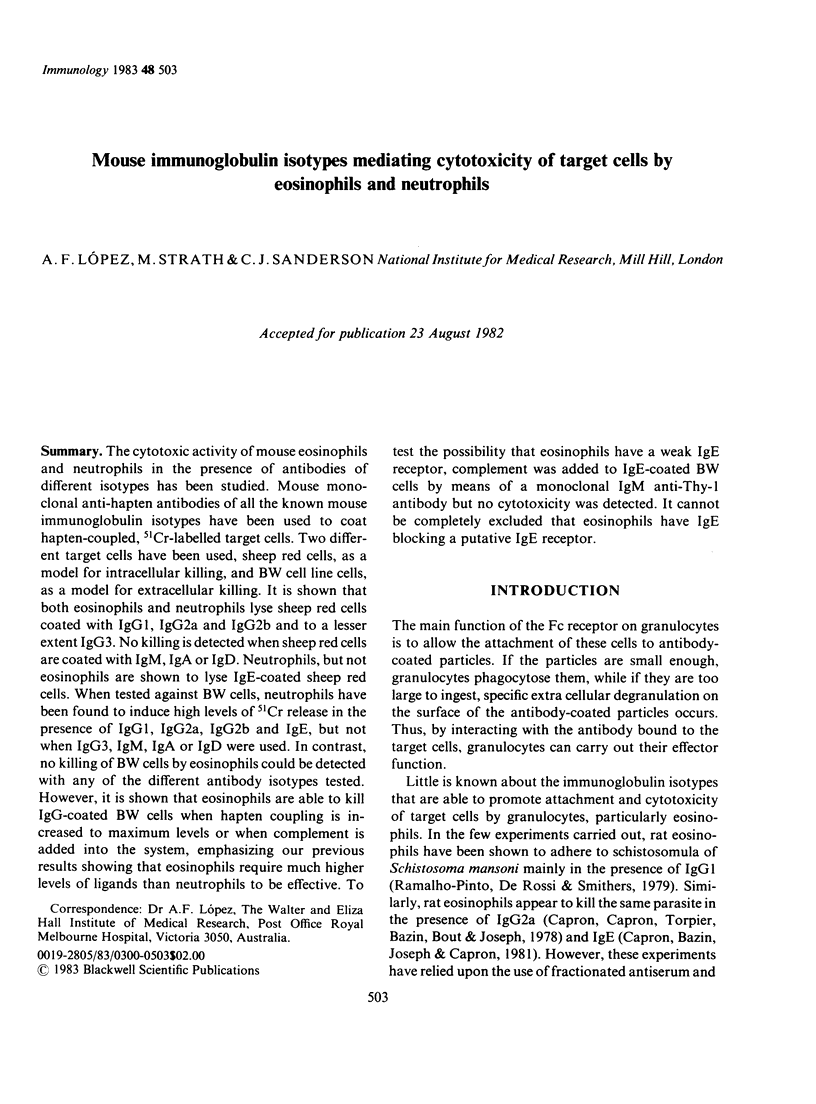
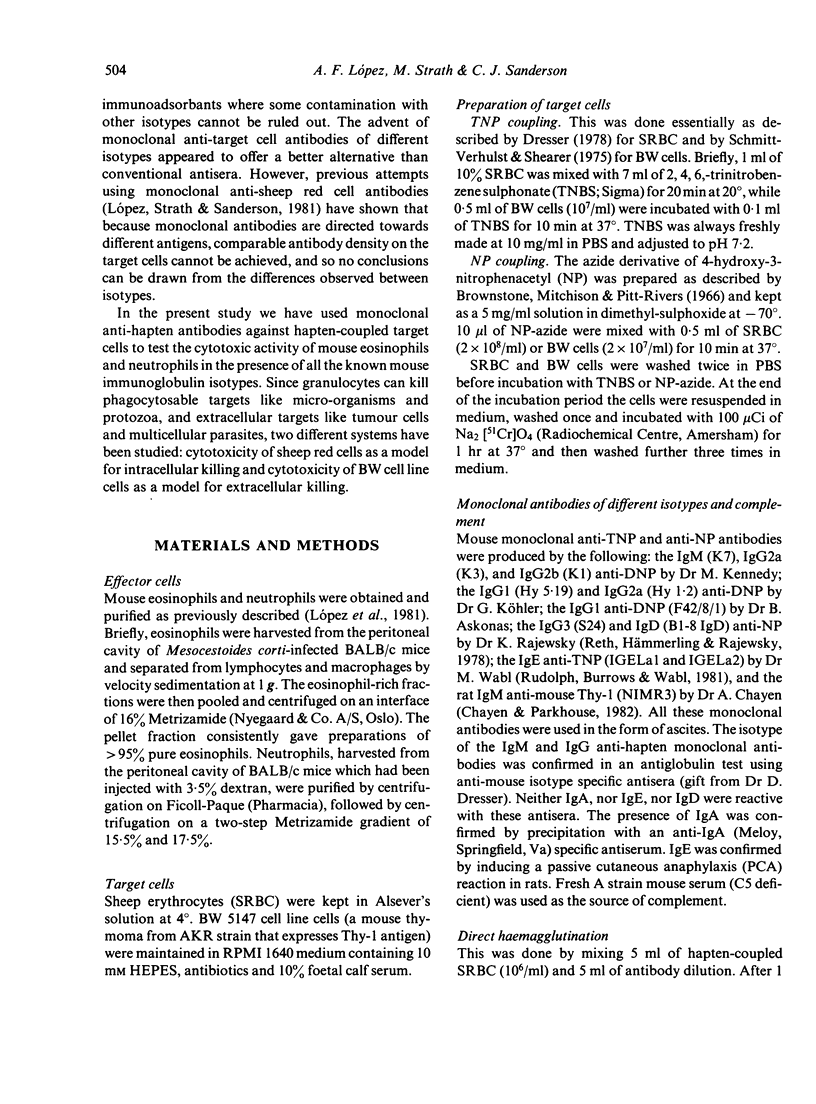
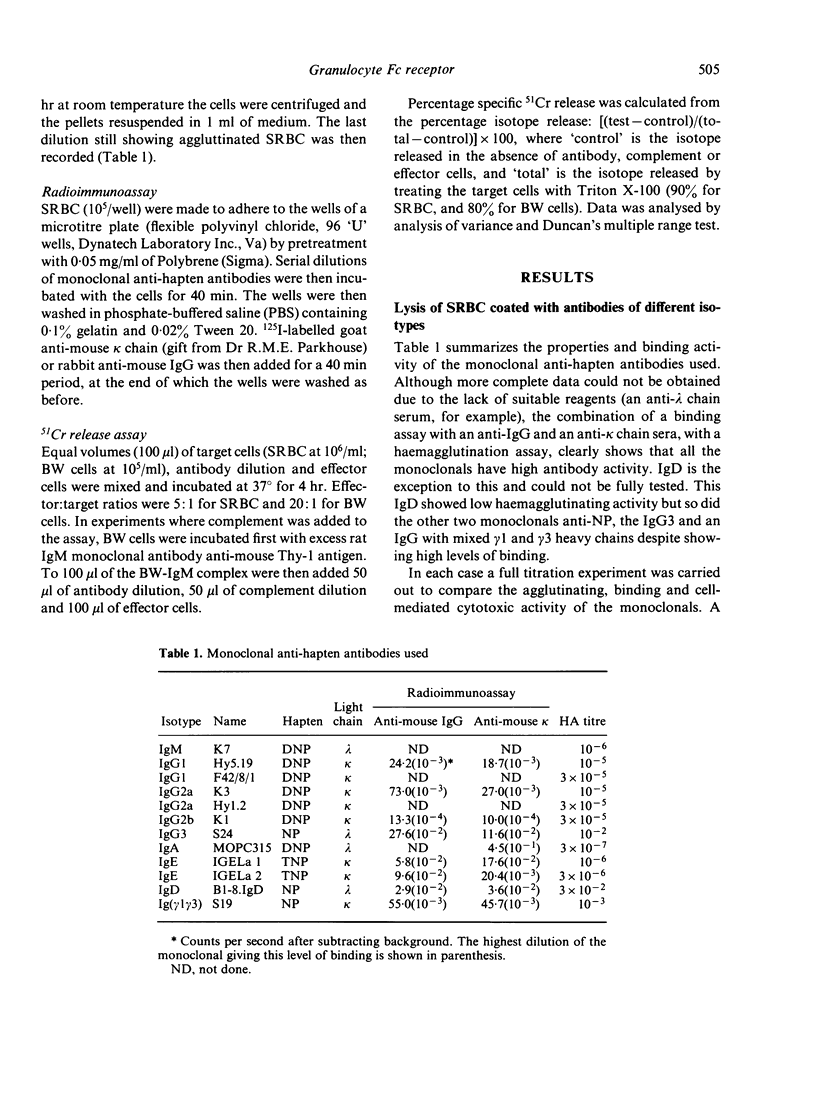
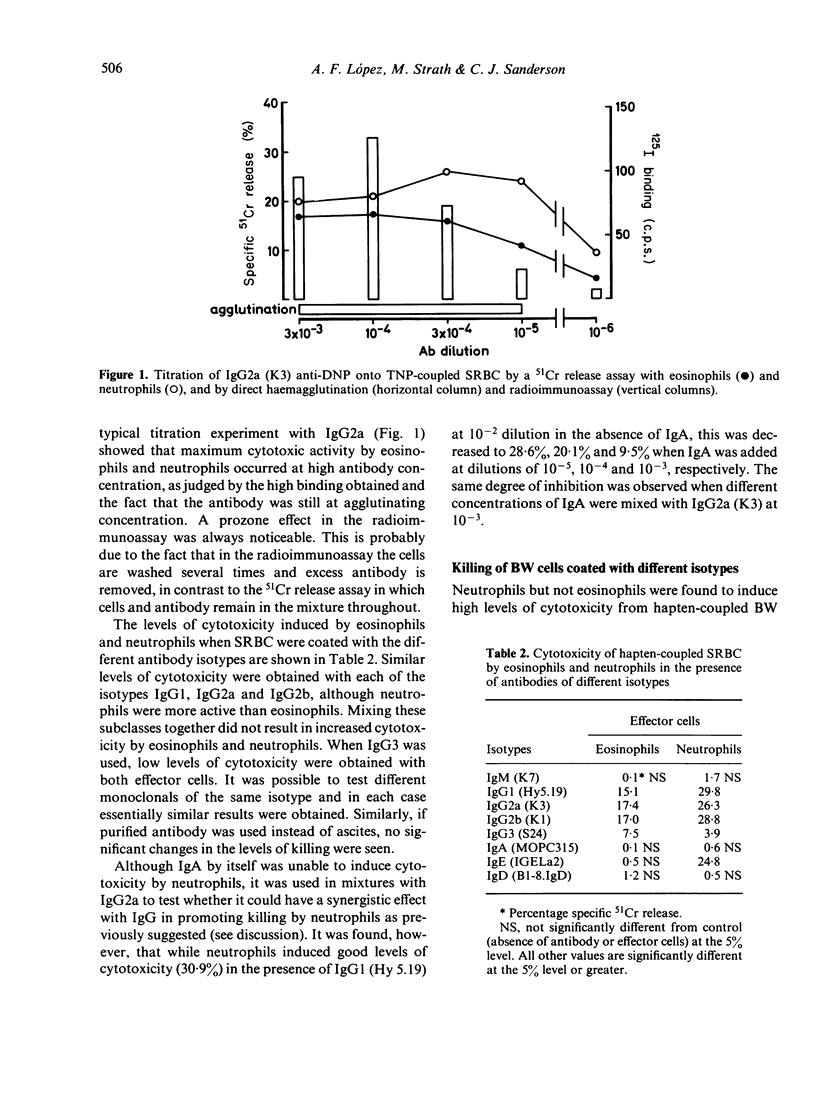
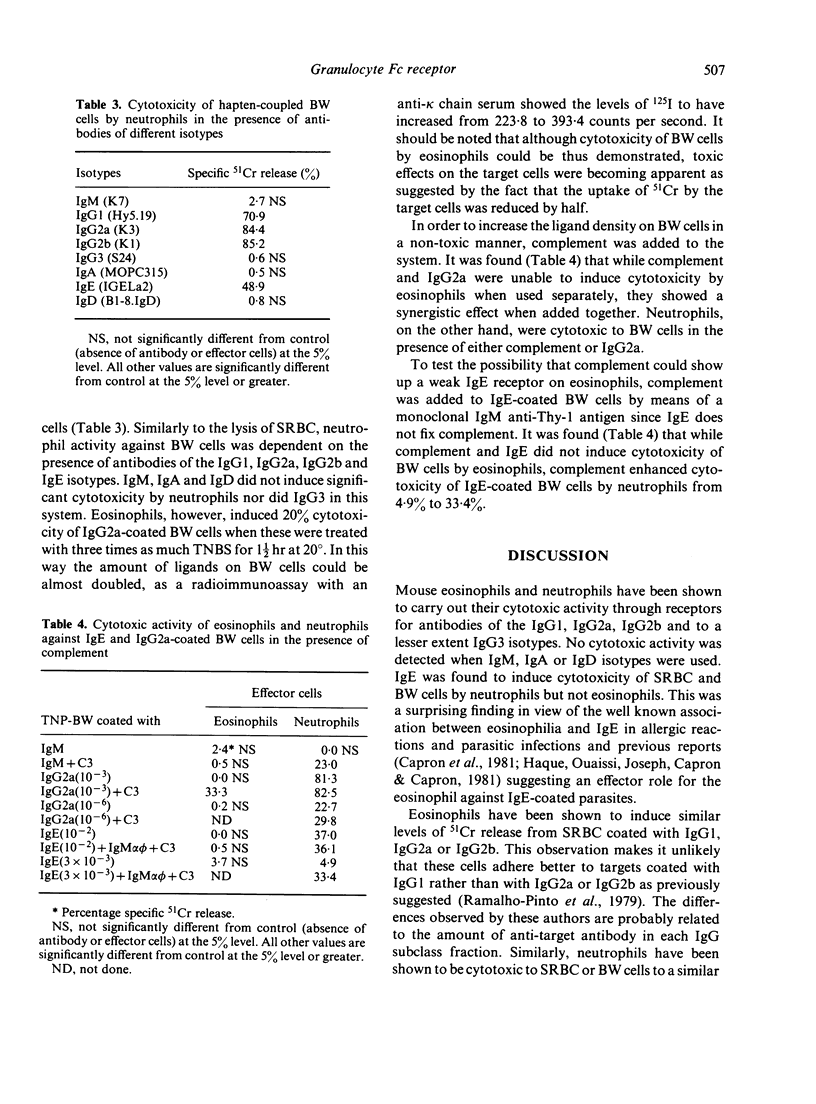
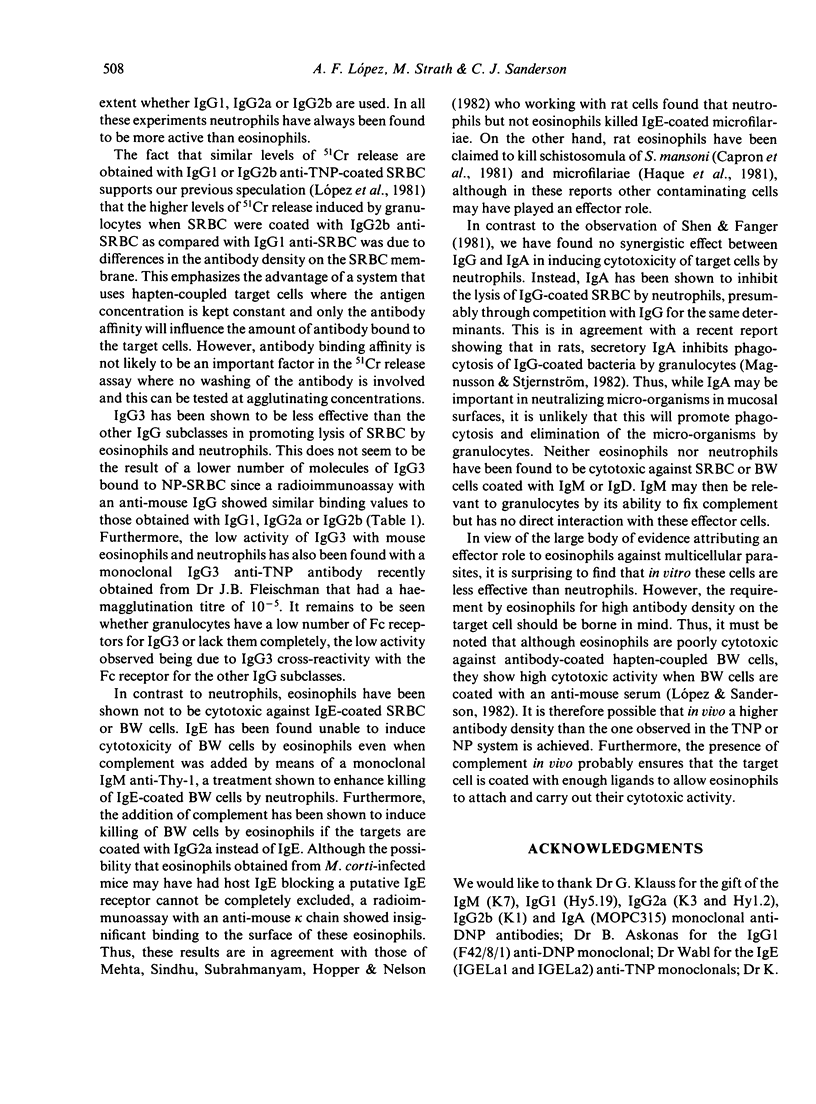

Selected References
These references are in PubMed. This may not be the complete list of references from this article.
- Brownstone A., Mitchison N. A., Pitt-Rivers R. Chemical and serological studies with an iodine-containing synthetic immunological determinant 4-hydroxy-3-iodo-5-nitrophenylacetic acid (NIP) and related compounds. Immunology. 1966 May;10(5):465–479. [PMC free article] [PubMed] [Google Scholar]
- Capron M., Bazin H., Joseph M., Capron A. Evidence for IgE-dependent cytotoxicity by rat eosinophils. J Immunol. 1981 May;126(5):1764–1768. [PubMed] [Google Scholar]
- Capron M., Capron A., Torpier G., Bazin H., Bout D., Joseph M. Eosinophil-dependent cytotoxicity in rat schistosomiasis. Involvement of IgG2a antibody and role of mast cells. Eur J Immunol. 1978 Feb;8(2):127–133. doi: 10.1002/eji.1830080211. [DOI] [PubMed] [Google Scholar]
- Haque A., Ouaissi A., Joseph M., Capron M., Capron A. IgE antibody in eosinophil- and macrophage-mediated in vitro killing of Dipetalonema viteae microfilariae. J Immunol. 1981 Aug;127(2):716–725. [PubMed] [Google Scholar]
- López A. F., Sanderson C. J. Antibody-dependent, cell-mediated cytotoxicity of nucleated mammalian cells by rat eosinophils and neutrophils. Int Arch Allergy Appl Immunol. 1982;67(3):200–205. doi: 10.1159/000233019. [DOI] [PubMed] [Google Scholar]
- López A. F., Strath M., Sanderson C. J. IgG and complement receptors on purified mouse eosinophils and neutrophils. Immunology. 1981 Aug;43(4):779–786. [PMC free article] [PubMed] [Google Scholar]
- Magnusson K. E., Stjernström I. Mucosal barrier mechanisms. Interplay between secretory IgA (SIgA), IgG and mucins on the surface properties and association of salmonellae with intestine and granulocytes. Immunology. 1982 Feb;45(2):239–248. [PMC free article] [PubMed] [Google Scholar]
- Mehta K., Sindhu R. K., Subrahmanyam D., Hopper K., Nelson D. S. IgE-dependent cellular adhesion and cytotoxicity to Litomosoides carinii microfilariae--nature of effector cells. Clin Exp Immunol. 1982 May;48(2):477–484. [PMC free article] [PubMed] [Google Scholar]
- Ramalho-Pinto F. J., de Rossi R., Smithers S. R. Murine Schistosomiasis mansoni: anti-schistosomula antibodies and the IgG subclasses involved in the complement- and eosinophil-mediated killing of schistosomula in vitro. Parasite Immunol. 1979 Winter;1(4):295–308. doi: 10.1111/j.1365-3024.1979.tb00715.x. [DOI] [PubMed] [Google Scholar]
- Reth M., Hämmerling G. J., Rajewsky K. Analysis of the repertoire of anti-NP antibodies in C57BL/6 mice by cell fusion. I. Characterization of antibody families in the primary and hyperimmune response. Eur J Immunol. 1978 Jun;8(6):393–400. doi: 10.1002/eji.1830080605. [DOI] [PubMed] [Google Scholar]
- Rudolph A. K., Burrows P. D., Wabl M. R. Thirteen hybridomas secreting hapten-specific immunoglobulin E from mice with Iga or Igb heavy chain haplotype. Eur J Immunol. 1981 Jun;11(6):527–529. doi: 10.1002/eji.1830110617. [DOI] [PubMed] [Google Scholar]
- Schmitt-Verhulst A. M., Shearer G. M. Bifunctional major histocompatibility-linked genetic regulation of cell-mediated lympholysis to trinitrophenyl-modified autologous lymphocytes. J Exp Med. 1975 Oct 1;142(4):914–927. doi: 10.1084/jem.142.4.914. [DOI] [PMC free article] [PubMed] [Google Scholar]
- Shen L., Fanger M. W. Secretory IgA antibodies synergize with IgG in promoting ADCC by human polymorphonuclear cells, monocytes, and lymphocytes. Cell Immunol. 1981 Mar 15;59(1):75–81. doi: 10.1016/0008-8749(81)90435-4. [DOI] [PubMed] [Google Scholar]


